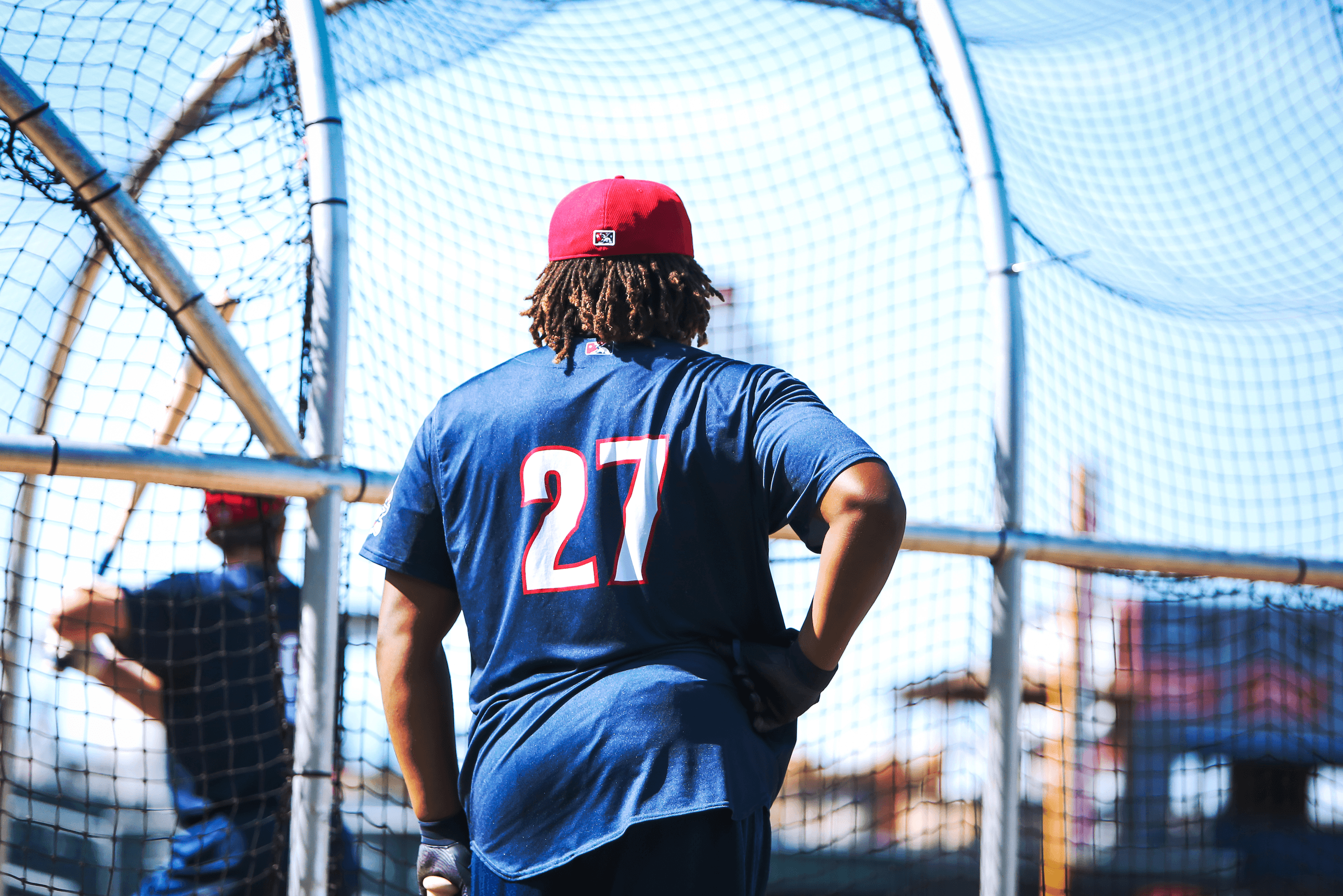Vladimir Guerrero Jr. Is Baseball’s Prince Who Was Promised
Toronto’s über-prospect is the son of a Hall of Fame legend, a human highlight reel, and, at long last, a major leaguer. He’s also carrying the hopes of a sport and the heft of his father’s legacy on his ample shoulders—all before his first MLB at-bat.Late last summer, San Diego Padres über-prospect Fernando Tatís Jr. sent a message to his longtime pal, the Toronto Blue Jays’ prized young minor leaguer Vladimir Guerrero Jr., asking the unanswerable question that had been haunting sports fans around the world all season long. “I texted him, like, ‘Bro, what else you gotta do to get called up?’” says Tatís, speaking by phone last August, his voice getting louder at the exasperating memory. “He said, ‘I dunno.’ I said, ‘OK, this is what I’m going to do. We’re going to Toronto. And we’re going to fight them, and then you’re gonna get called up no matter what.’”
Tatís’s master plan may have been facetious, but his frustration was real: He sounds less like a fellow professional ballplayer and more like Fernando from San Diego calling into Toronto sports radio to vent about how one of the most popular, exciting players in the Blue Jays system—and arguably in all of baseball!—maybe ought to actually suit up for the Blue Jays, for crying out loud; he’ll hang up and listen. Guerrero has a way of drawing this sort of ragged enthusiasm out of just about anyone who watches him play baseball, from the most casual fan to the most hardcore nerd.
Vlad Jr., the son of Hall of Fame outfielder Vladimir Guerrero, who amassed 449 home runs in 16 MLB seasons, is a generational mosaic. He has the soft, smiley visage of a sweet roly-poly baby; the thicc physique of a mid-to-late-career MLB power slugger; and, unlike his swing-at-everything father, a plate discipline that would charm even the saltiest old armchair baseball purist. He is baseball royalty, with the patrilineal namesake to prove it and a pair of orange mirrored sunglasses that, when flipped up on his head, gleam golden in the sun like a crown atop a boy prince.
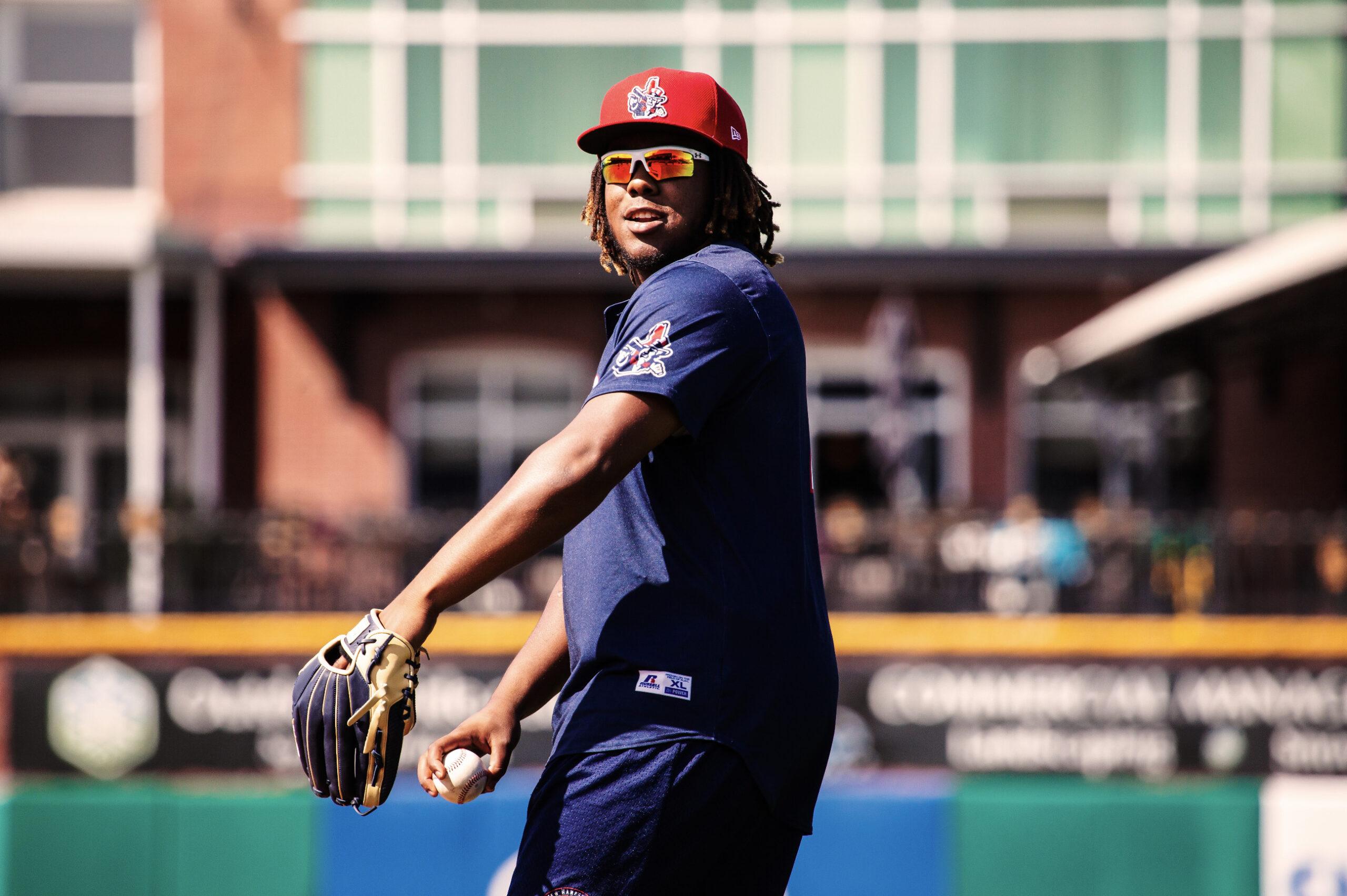
With his ties to the nostalgia for his dad’s past and his potential for a prosperous future, he has long been a subject of fascination and an object of attention not only in Toronto, where he signed for $3.9 million with the Blue Jays as a 16-year-old in 2015, but more broadly across the sport’s global realm. And at long last, after a full season and change of foot-dragging and lawyerly dissembling from the Blue Jays’ powers that be, Guerrero’s long-awaited coronation will finally—finally!—take place on Friday night.
Tatís and Guerrero, both 20 years old, go way back—with each other and with baseball. “We text each other every day,” says Guerrero in early March, standing outside the Blue Jays spring training clubhouse, wearing a toque on his head on a bitter-cold morning by Florida standards. “So we’re always in touch.” Their namesake fathers each had lengthy MLB careers that overlapped for a few seasons up in Montreal. The boys, 3 or 4 at the time, would bop around the Expos clubhouse and toddle back and forth between the bases at Olympic Stadium after games. They grew up to become not only ballplayers themselves, but potential game changers: Entering the 2019 season, Guerrero and Tatís ranked as the no. 1 and no. 2 prospects across the league, per the scouting service MLB Pipeline.
Both of them, in other words, have always been well acquainted with the quirks and vagaries of that pro baseball life, with all the thrills and disappointments and bureaucratic weirdnesses that it entails. And yet Tatís still found himself baffled by his buddy’s static status quo, by the fact that one of baseball’s most exciting talents could knock balls out of parks all season long yet still stay kicking around the minors, friendly and confined, competing against teams with names like Rumble Ponies and IronPigs. “I think with the work I’m putting in,” says Guerrero, who, with the exception of an elite Instagram airport-location troll last May, has mostly downplayed the situation, “I’m getting better every day.” It is both a bland statement and an electrifying thought.
Guerrero has consistently turned his minor league at-bats into main events. His reputation precedes him, in part because of his famous lineage but also because of all he has done to live up to that family name. He has raked long balls into brick-laid hotel walls and out of parks altogether; he has capped off a four-hit performance with a game-winning home run for good measure; he has elevated a novelty spring exhibition into an impromptu moment of soaring Canadian national pride, hitting a walk-off blast in the same Montreal stadium where his father once played with the Expos for the first half of his career, surely one of the goose-bumpsiest moments in spring training history.
Still a teen last fall when he earned baseball’s Minor League Player of the Year honors, Guerrero was both a boy among men—the average batter in Triple-A, where he finished out last season playing for the Buffalo Bisons, was seven and a half years older than him—and a man among boys, hitting 20 home runs in the minors and flirting with .400 for most of the summer, across levels. He is the only prospect whose “hit tool” has ever earned the best possible grade, 80, from MLB Pipeline. Across his three seasons in various levels of the minors, he walked more often (150 times) than he struck out (139), an impressive achievement for such a young guy with such a big swing.
Guerrero is the son of a legend. He is a human highlight reel in his own right. And—no pressure, really!—he has come to be the whole sport of baseball’s next great hope, all of this without having yet taken a big league at-bat. The hope is that after that last part finally changes on Friday night, little else will.
On an early March afternoon down at the Blue Jays’ 2019 spring training in Florida, there are many giddy Vladheads in the crowd, all of them yelling out “VLADDDDY!” as if they’ve always been on a familiar diminutive-name basis with baseball’s biggest boy. It’s a cheerful Sunday in Dunedin, a town near Tampa Bay that features shops with names like The Great Giftsby, large ospreys nesting in trees and atop utility poles, and, this time of year, some truly excellent chances to glimpse Guerrero do the thing he does best: completely demolish the ball. A loud cheer rises throughout Dunedin Stadium in the bottom of the second inning when Guerrero, who plays third base, steps up to hit against the Yankees and writes “DIOS” in the infield dirt with the tip of his bat. As he hovers over the plate, the familial resemblance between the two Vladimirs Guerrero is unavoidable.
Young Vladito is both the spitting image and the Pokémon--like evolution of his eccentric, beloved father. Both have heaping bodies, though Junior’s is far beefier. (Far, far beefier if you compare them at roughly the same age.) At various times they have each worn their hair long, hanging down past their batting helmets, though Junior’s current blond look is bolder than his dad’s ever was. Both run with an arm-flailing, high-hipped, romping gait. And their swings, when viewed side by side, clearly share significant genetic makeup: the same knock-kneed stance, the same roundhouse swat, the same powerful, enthralling results that bring people to their feet or stop them in their tracks.
“People come into the world and do something,” says Wilton Guerrero, the elder Vladimir’s brother and Vlad Jr.’s uncle, speaking by phone from the town of Don Gregorio in the Dominican Republic, where he runs the family’s well-regarded baseball academy. “Some people play basketball, some people have a different job.” But when it comes to the Guerrero family, Wilton says, they were born to play baseball.
Wilton once played in the big leagues himself and was, for a time, considered a surer shot than his brother Vladimir. One of Vlad Jr.’s cousins appeared in 14 games for the Reds last season and even knocked one out of the park; numerous other family members—uncles, cousins, cousins once removed—played for various minor league operations. Vladimir and Wilton’s mother, Altagracia Alvino, lives with and cooks for her grandson the way she once did for her own kids (and all of their teammates, and often many of their opponents), moving with him from one town to the next. When Wilton’s own eight-year MLB career ended, he returned home, training his nephew as Vladimir Sr. continued to play in the major leagues.
Guerrero Jr. was born in Montreal during his father’s time playing there, a provenance that might not have endeared him to rival Blue Jays fans back in the Expos’ brief heyday. But that team’s relocation out of Canada and his ultimate signing in Toronto have made Guerrero a sort of shared cross-Canadian delight. He has the playful confidence of a young man who grew up among bottomless bowls of ice cream in major league clubhouses. “Always swinging a little bat, eating always, always eating,” recalls Pedro Martínez, one of Guerrero’s godfathers (Andrés Galarraga is the other), as he speaks by phone from his office at MLB Network’s studio. Junior captured hearts early in life. Behold him as an impossibly cuddly toddler standing next to his dad, doffing his little helmet to an admiring Montreal crowd and sporting a tiny Expos uniform, his personal version of Prince George in a sailor suit.
When Guerrero was 6, Wilton started working with the boy in the batting cage in Don Gregorio, and by the time Guerrero was 11, “I train him every day,” Wilton says. “I throw him like 100 pitches every day.” (Guerrero says that Wilton and his father “are the same person, I think.”) According to Kendrys Morales, who has spent time in clubhouses with both generations of Vladimir Guerrero, Junior’s natural talent didn’t instantly turn him into some baseball bot. “He loved being on the iPad,” recalls a chuckling Morales. “He didn’t like playing baseball. He didn’t like going outside and playing with us.”
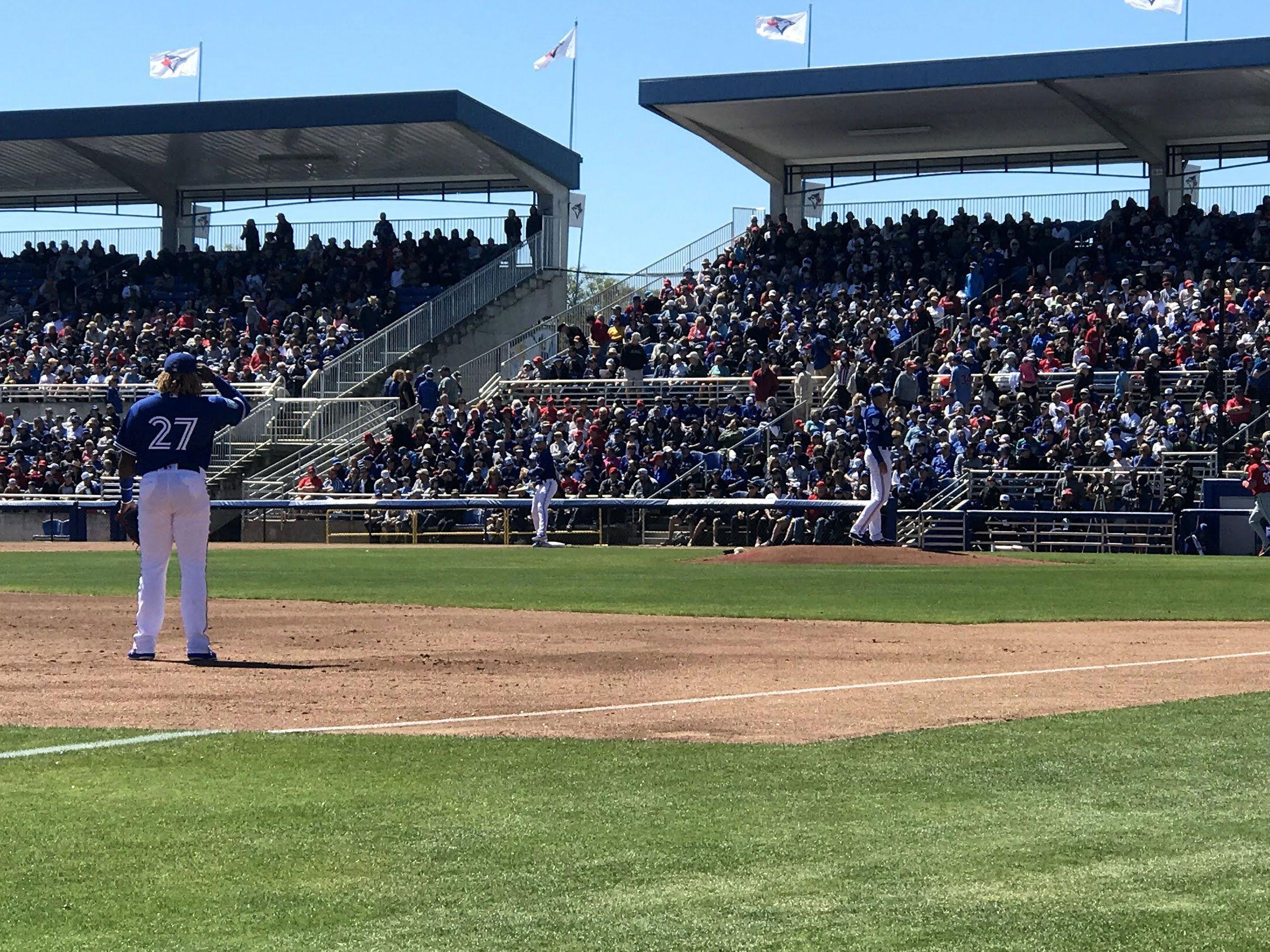
Efforts to reach Vladimir Guerrero Sr. for this piece were unsuccessful, but when Sportsnet’s Stephen Brunt traveled to Don Gregorio in the summer of 2018 to meet him, Senior insisted that his son’s interest was real and self-started. “I never told him to play,” Guerrero told Brunt. “He’s always liked it. He always had the enthusiasm to play.” Either way, there’s no question that these days, Guerrero is all baseball, all the time: His preferred non-baseball (“non-baseball”) activity is playing MLB the Show on his PlayStation. (This may be another case of the apple not falling far: Tom Verducci once described Vlad Sr. as spending two hours before a Montreal game on a clubhouse PlayStation, playing as the Expos; this constituted the bulk of his research on opposing pitchers.)
At the plate in Dunedin, Vladito receives ball four, or so he thinks. He tosses his bat aside and trots toward first base, a familiar motion for a player so accustomed to drawing walks. The umpire, who has ruled a strike, calls him back. Guerrero seems a bit miffed, and his next swing is almost an eye roll of a motion, dismissive and fluid, his top hand coming off the bat altogether, the whole thing looking kind of like a tennis player practicing a smooth, demonstrative backhand slice up at the net—a smooth, demonstrative backhand slice that makes a sound like a giantess clapping the sand off a pair of boat-sized clogs and generates enough power to send the baseball, surely as shocked as any spectator, some 300 feet toward left field, where it caroms high off the wall, just inches from being, essentially, a one-handed home run.
He loved being on the iPad. He didn’t like playing baseball.Kendrys Morales, Oakland A’s hitter and family friend
A second-inning double in the early days of spring training isn’t usually the kind of thing that captures hearts and racks up retweets, but things have a way of changing quickly anytime Guerrero and his bat get involved. (Unless that thing happens to be “his team assignment,” to be fair.) Within a few minutes, the official Twitter account for Major League Baseball has posted footage of the hit with the caption “Vlad Jr.’s swing is effortless,” one more entry in the increasingly robust genre of “did you see what Vladdy just did?” After the game, a reporter asks Guerrero why he chose not to wear gloves for that at-bat. Did it have anything to do with his father, who batted with bare hands? Guerrero responds that he was just getting sweaty, so he took them off. Not everything has to be an homage.
“I can’t believe how the time passed,” says Martínez, talking about his large adult godson. “It seems like I had the little kid in my arms, and then all of a sudden I see this big monster that’s hitting balls 450 feet out to the opposite field. And it’s like, oh my God, am I getting that old, that soon?”
Indeed, Guerrero has always batted with both the power and the precision of someone beyond his years. Gil Kim, the Toronto Blue Jays’ director of player development, recalls going down to the Dominican Republic to check out a different player from Wilton’s academy for Kim’s former employer. “They ended up throwing Vladdy out there,” Kim says in a phone conversation from his office in Dunedin. “He was either 12 or 13 years old, and just hitting home runs out of the field. So that was—that was kind of different.” Guerrero’s $3.9 million signing bonus was a bit more than the $2,500 check his father initially got from Montreal in 1993, though not anything noteworthy compared to what some other top international prospects can get.
Since then, he has consistently put up numbers, at each successive level, that have placed him in a rare tranche; names that frequently surface as statistical comparables are ones like Mike Trout, Giancarlo Stanton, and Manny Machado. Guerrero plays with a combination of contact and power that is unusual to pull off; Cavan Biggio, another Jays prospect with a famous ballplayer for a father, calls it “not normal in someone his age.” Guerrero may be best known for the videos of his exquisite dingers, but he’s also an astonishing all-around hitter who can place the ball all over the field.
“He’s always on time,” says Justin Smoak, a Blue Jays first baseman and power hitter himself, describing what differentiates Guerrero’s stroke, which looks the same whether he’s pelting line drives to first base in batting practice or landing the ball in a faraway parking lot in a game. “Being on time and doing things the right way mechanically, [the ball’s] gonna come off different,” Smoak says. “And he’s able to repeat that, time and time again.” Danny Jansen, a catcher who is part of the Blue Jays’ promising next generation, says that what really stuck out to him when he played with Guerrero in Buffalo last season was a plate discipline well beyond his years. “Like, the guy wouldn’t swing on a ball that was, you know, half a ball off,” Jansen says. “He’s got his approach, and it’s a very advanced approach, and he sticks to it.” Biggio also points out Guerrero’s ability to iterate on the fly: “He’ll get fooled once an at-bat,” Biggio says, “but what I’ve noticed is that he’ll never get fooled twice an at-bat.”
I can’t believe how the time passed. It seems like I had the little kid in my arms, and then all of a sudden I see this big monster that’s hitting balls 450 feet.Pedro Martínez, Guerrero’s godfather
Given this sort of generational talent, and given the numbers Guerrero began putting up in Double-A (.402/.449/.671) and Triple-A (.336/.414/.564) last season, it felt wrong and bad when it became clear that the Blue Jays intended to leave Guerrero in the minor leagues to take advantage of an unpopular “service time” loophole in the collective bargaining agreement that would allow them to nickel and dime their way to an additional year of contractual control over Guerrero in the future—all in exchange for denying Toronto fans a chance to see the most entertaining baseball possible right now. “It was so obvious,” Chicago Cubs third baseman Kris Bryant told The Athletic in February about his own delayed call-up in 2015, over which he filed a grievance. He added that Guerrero Jr. would probably hear the same rationales he did: “‘Oh, he’s gotta work on his defense,’” Bryant said. “Stuff like that.”
An injury to Guerrero’s oblique muscle during spring training sidelined him past Opening Day anyway, and the Blue Jays avoided having to address the issue constantly, the way they would have if he were healthy and mashing in the minor leagues daily. But the team had already drawn criticism by then for the various ridiculous things said with unbelievably straight faces to justify the organizational plan. Early during this year’s spring training, Toronto general manager Ross Atkins said that “Vlad Guerrero Jr. is not a major league player right now.” (An astute Redditor compared Atkins’s chipper, noncommittal tone to a restaurant manager delivering bad news in a Curb Your Enthusiasm episode, a comparison that is hard to unsee.) His remarks were reminiscent of the ones team president Mark Shapiro made early last fall, when he went on MLB XM radio to defend the team’s decision not to add Guerrero to Toronto’s expanded September roster despite his masterful season, an appearance that prompted the Major League Baseball Players Association to issue a harsh statement two days later.
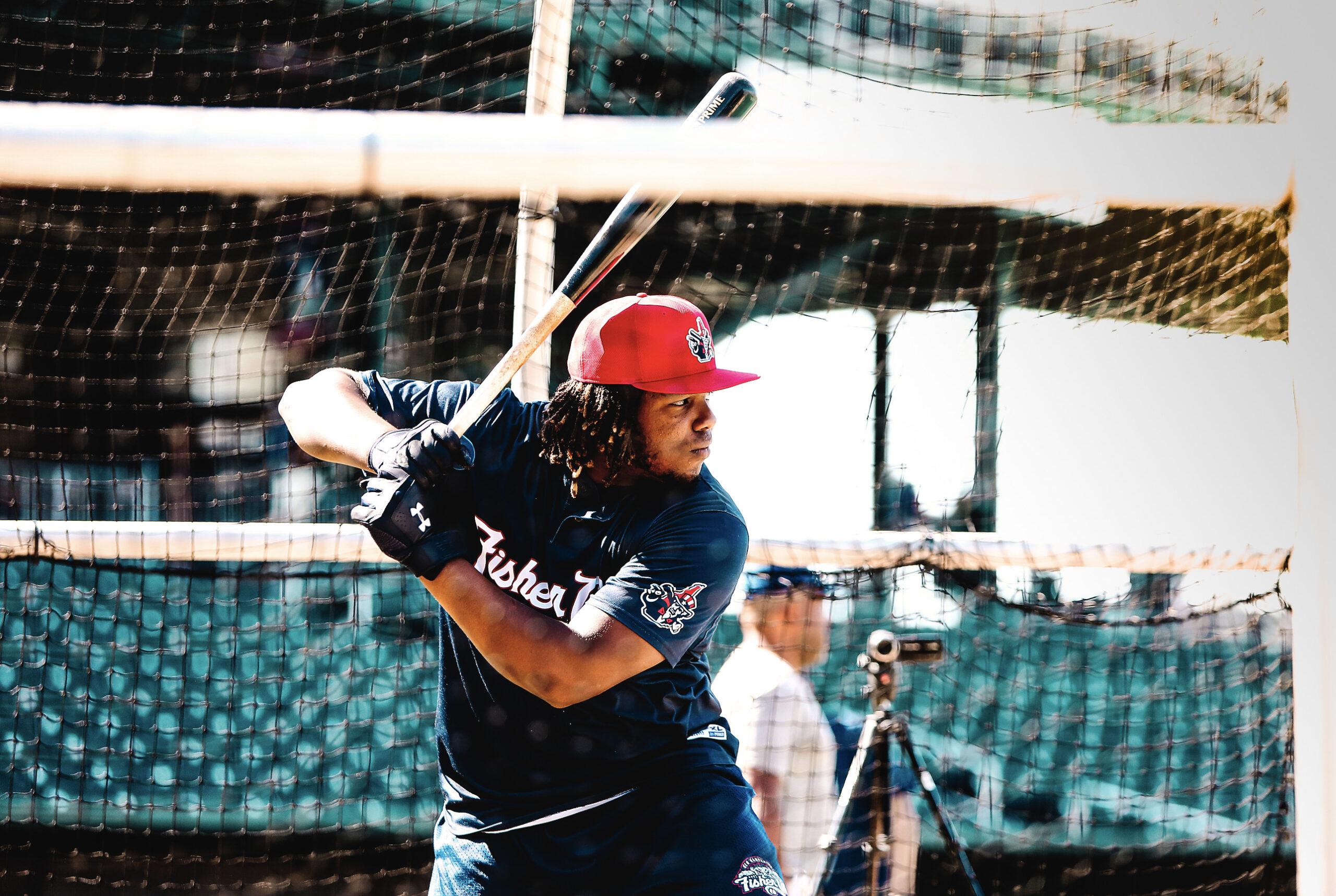
An MLBPA spokesperson called Guerrero’s prolonged stints in the minors “service time manipulation” and added that “the decision to not bring him up is a business decision, not a baseball decision. It’s bad for the Blue Jays, it’s bad for fans, it’s bad for players and it’s bad for the industry.” This season, several franchises have opted not to monkey with service start dates and just field the best players they can, and their decisions have paid off. Pete Alonso, Eloy Jiménez, and Tatís—all of whom would have been prime candidates for the tactic—were in their respective lineups on Opening Day, and their teams are all better off for it.
Blue Jays manager Charlie Montoyo remembers the scorched mayflies. Playing baseball in Harrisburg, Pennsylvania, in the early ’90s meant having the image permanently seared into one’s mind: The summer swarms of insects that would fly toward the stadium lights as the sun set, die tiny deaths, and then fall, hundreds of little Icaruses settling over everyone in attendance, a constant reminder that this was, indeed, minor league ball.
Vladimir Guerrero Sr. and Montoyo played together in that lovely setting, before the elder Guerrero was promoted directly to the majors from Double-A, sans shenanigans. Guerrero was a raw talent indeed: He eschewed batting gloves, preferring instead to load up his cap with globs of pine tar; he sometimes grabbed teammates’ random bats on his way to the plate, just to give ’em a try; he showed up to a scouting combine in the Dominican Republic wearing two different-sized shoes and wound up being signed by Montreal. (“TUF NOSED PLAYER,” read Expos scout Fred Ferreira’s evaluation from that day. “NO FOUND WEAKNESS—UNUSUAL.”)
Playing at the same Double-A level with the New Hampshire Fisher Cats last summer, Guerrero didn’t have to sacrifice his dignity or dodge falling dead bugs in quite the same way as his dad did. But his presence still feels outsized in the small Manchester stadium, particularly when combined with that of some of his teammates. “I’ve said that we’re like a traveling boy band,” remarks New Hampshire Fisher Cats skipper John Schneider several hours before a home game in the Double-A-level Eastern League in Manchester, New Hampshire, last July. (Following his own big league promotion, Schneider is currently on the Blue Jays coaching staff.) The town is bustling on this summer weekend: Its expo center features a tattoo convention, and the Fisher Cats are holding a three-game homestead at Northeast Delta Dental Stadium that includes two of their biggest fan nights—Harry Potter Night and Star Wars Night.
What’s more, the team offers fans a chance to see three different young players with proud baseball names: Bo Bichette, the 20-year-old son of the retired MLB slugger Dante; Biggio, the 23-year-old son of Hall of Fame player (and Astros special assistant to the general manager) Craig; and of course Guerrero, who is back in the lineup after having missed some time with a knee injury. With such an enticing roster, the Fisher Cats will finish the season with both an Eastern League title as well as a 12 percent bump in attendance from 2017, a higher increase than any other Double-A team.
He’ll get fooled once an at-bat, but what I’ve noticed is that he’ll never get fooled twice an at-bat.Cavan Biggio
Well, for one night, at least. Guerrero records one hit in a Friday-night game but is given a rest on Saturday, much to the chagrin of a fan in a Montreal Expos cap named Pascal Parent, who strolls along the Delta Dental concourse with a companion, looking extremely bummed out amid the other fans in their Patriots hats or their Star Wars garb. Hoping to see the son of one of his very favorite Expos, “I was checking the net for so long,” Parent says, waiting to see when Guerrero would return to the lineup. He bought tickets for two weekend games, and made the four-hour drive down from Montreal.
“When I saw the lineup,” Parent says, smiling ruefully, sounding like a Broadway ticket holder being confronted with a dreaded understudy, “I was like, ‘Noooooo!’” The next day Parent is back again, standing outside the stadium shivering hopefully under a raincoat, minutes away from learning that his other chance to see Guerrero has been rained out. Such is life in the minors.
In a twisted sense, though, it was apt that this poor guy never got to see Guerrero up close, considering how hard it was for even the most fervent baseball fans to watch the elder Guerrero play in his prime. In 2004, Sports Illustrated relayed a Guerrero family story about a premonition voiced by Vladimir Guerrero’s maternal grandmother. “All your boys play baseball well,” she told her daughter, Alvino. “But this one—Vladimir—someday will be a famous pelotero. I won’t live to see it, but the ants will come and tell me in my grave.” Both parts of her prophecy came true, in a sense: the famous pelotero part, and the part about it taking place out of sight. (Probably also the ants.)
Guerrero’s ramshackle aesthetic and sandlot vibes, combined with the fact that fans had to work so hard to see them, made Guerrero seem more like a legend of yore than a contemporary of, say, Josh Hamilton. He windmill-threw relay balls that either missed their target entirely or provided for-the-ages highlight reel plays. He lunged toward bad pitches like a tennis player stretching to make a desperation groundstroke. He even hit balls that first bounced in the dirt in front of him as if—as he explained it to Carlos Peña in an MLB Network segment—he were a kid again, playing a cricket-like game called la placa, just trying to make contact.
“Most of the good things Vladdy did,” says Martínez, “were not seen by anybody. … Imagine the kind of numbers Vladdy put up if he were in a place like New York or Boston or maybe L.A.!” The Montreal Expos were in the twilight of their existence when Guerrero played for the team, and attendance was consistently poor. “Certainly,” wrote FiveThirtyEight’s Neil Paine early last year, “no recent Hall of Famer was seen by fewer people in person during his best seasons than Guerrero.” Nor was he easily viewed on TV. In 2000, a year in which Guerrero hit 44 home runs, batted .345, and turned in an OPS of 1.074, the Hartford Courant reported that the Expos “still don’t have a TV contract for this season, and games on the radio are broadcast in French.”
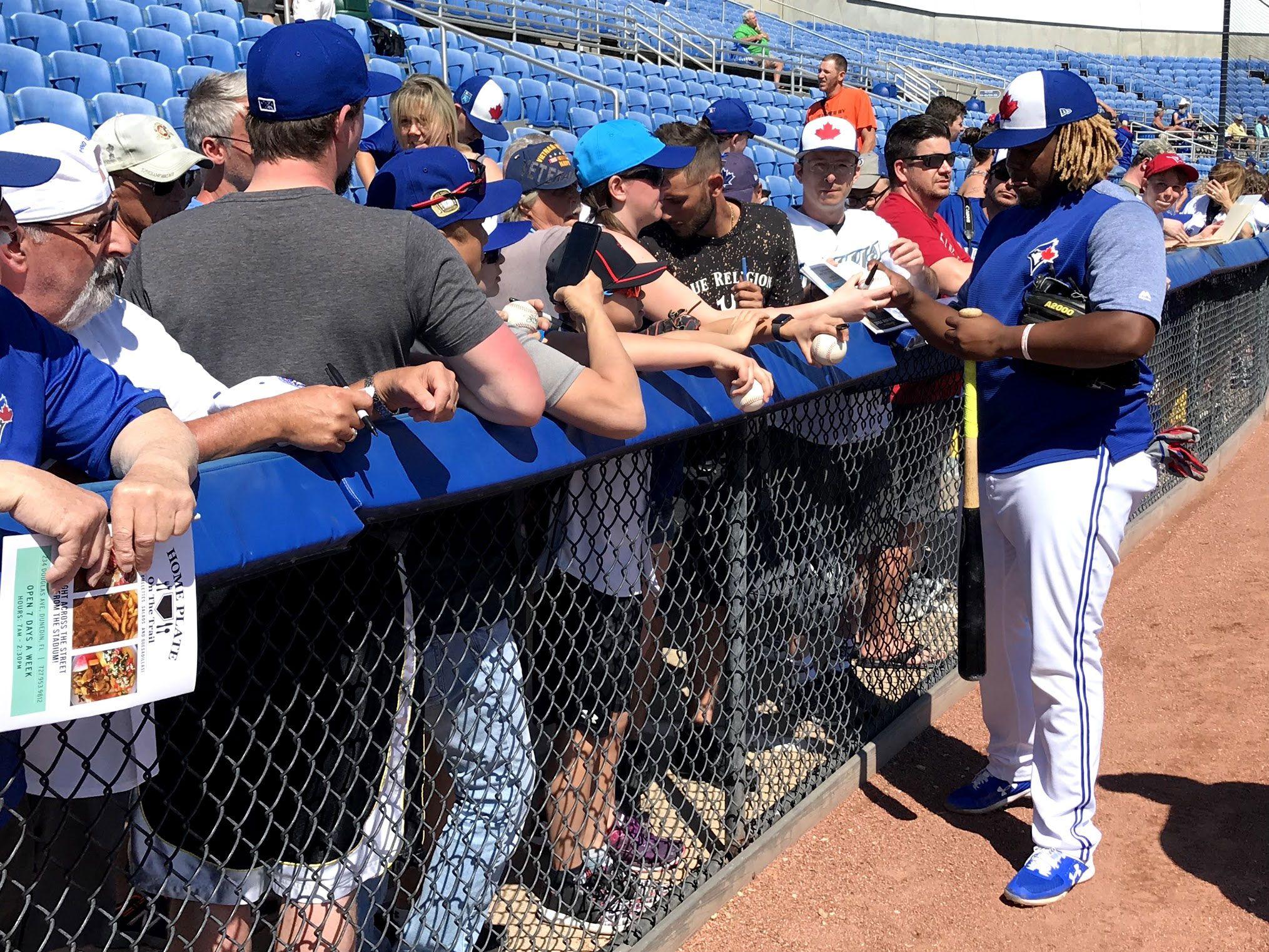
“You know, he wants to play baseball,” Martínez says, “and yet he doesn’t want to be seen by anybody. So Montreal might have been the perfect fit for Vladdy.” The mythical qualities of father and son have obvious shared roots but also branch in opposite directions. Fans saw, relatively speaking, so little of what Vlad Sr. could do that it turned him into an almost Bunyan-like figure of lore. When it comes to Vlad Jr., though, his every move is recorded and disseminated and replayed all over the world, and his legend grows with every at-bat. Part of Senior’s mystique was his scarcity, while much of what has already made Vladito so mighty is the abundant evidence of his powers. His father shied away from the media and had the ability to do so; there’s no chance Guerrero could ever escape. He is interviewed constantly by scrums of local and national media and followed around by TV camera crews; he is asked the same stuff day after day.
Though sometimes the questions do change up a bit: In New Hampshire one day, a reporter asks Guerrero about a recent Jumbotron bit featuring the slugger explaining Spanish terms. Might Guerrero Jr. have a future career in education when baseball is done? As the interpreter relays this query to the big guy, Guerrero Jr. smirks. “Well,” he says, “I haven’t even thought about my retirement yet.”
Smoak stands in the Blue Jays’ Dunedin clubhouse and nods his head to his right, over toward where Bichette and Biggio and Guerrero sit, and then makes a big circular all-encompassing motion with his hand. “See, like, this?” he says, meaning all of it: spring training, pro baseball, the pressure, the boredom, the grind. “This doesn’t scare them. You know what I mean? This doesn’t intimidate them. They’ve been in these clubhouses since they were kids.” He compares them with himself back in Texas, where he spent the first half of his rookie season in 2010 and overlapped with Vlad Sr. “Rather than me, coming in as a first time, looking around, going, ‘Holy cow, my locker is next to Josh Hamilton!’ You know what I mean?”
All of this is familiar to Guerrero’s friend and contemporary, Tatís, who has discussed with his own dad how different their early years as pro players were. “We have talked about how [my father] came up,” Tatís Jr. says. “How hard it was for him not knowing the language, and coming up by himself … how he had to cook for himself, because he didn’t even know how to order when he went to a restaurant.” No one has to say things like welcome to the big leagues, kid to these guys; they’ve lived it. “Everything is different,” says Wilton Guerrero. “Vladdy Sr. had nothing. Vladdy used to be quiet because he don’t know nothing. And then Junior has a father who is in the Hall of Fame. Everything is ready for Vladdy Jr. now. He knows something because of his father.” (As for said father, he told ESPN in 2017 that he was still adjusting to his new “Senior” nickname. “It’s no good,” he said then. “Maybe in three years. It makes me sound old. I’m Vladimir Guerrero. I’ve always been Vladimir Guerrero.”)
Everything is ready for Vladdy Jr. now. He knows something because of his father.Wilton Guerrero, Guerrero’s uncle
The elder Guerrero spoke neither English nor French and didn’t like attention. (He would later earn the occasional nickname “El Mudo”—The Mute.) In 1997, Guerrero’s official rookie season, a foot fracture kept him out of the first 26 games of the year; upon his return he batted .302, hit 11 home runs, and finished sixth in NL Rookie of the Year voting. (Philadelphia’s Scott Rolen was the unanimous winner.) “I remember how shy he was, how confused,” says Martínez. “Not only about the injury, but about, you know, searching about ‘Where am I going to stay, who’s going to take care of me, what’s going to happen?’” Martínez took Guerrero “under my wings,” he says. “Take care of him, take him to the stadium, take him to eat and stuff like that. Like a little brother.”
By the end of his 16-year career, Guerrero would ultimately pay the gesture forward. While on the Angels, he formed a relationship with a young Morales. “I visited him at his house in Anaheim and the DR,” says Morales. “Vladimir doesn’t talk a lot, or express himself, what’s on his mind. But to hit you have to be smart aside from having talent, and I paid a lot of attention to what he did.”
Morales is standing next to his cubby inside the Blue Jays’ spring training clubhouse, which at the moment is a popular hangout spot. Most mornings in Dunedin, there are either several humans loitering in front of his locker, or there are several abandoned chairs where those humans recently sat. Guerrero sits next to Morales, and Lourdes Gurriel Jr. and Teoscar Hernández frequently drop by. “We have a trust together,” Guerrero says. “We’re like father and son. I go to his locker and grab something from there, he comes to mine and grabs something from there. Like, what’s his is mine and what’s mine is his.” A few weeks later, Morales will be traded to Oakland; baseball is a family, until it’s not.
It’s a challenge to beguile someone like Guerrero Jr., who grew up completely surrounded by sporting supremacy, but it’s still possible to catch his eye. He likes watching basketball and grew up loving Kobe Bryant. “I’ve always been a Lakers fan,” he says, “and now even more that LeBron is there.” And he routinely brings up one of his favorite baseball players: third baseman Adrián Beltré.
“I think I have the same game he has,” he tells reporters in New Hampshire. More recently, in Dunedin, he says he met Beltré last year during a clinic the retired player was holding in the Dominican Republic. “With my dad, I always saw David Ortiz, and Albert Pujols, but I was more comfortable talking to them,” Guerrero says, adding Manny Ramirez’s name to that list too. “But when I talked to Adrián Beltré, that’s when I was a little starstruck.” Danny Solano, the Blue Jays’ minor league infield coordinator, brings up Beltré too in a phone conversation. “He wanna be Adrián Beltré!” he exclaims, when asked who a model for Guerrero’s game might be. “I know they have different kinds of bodies and that stuff,” he says, “but he works like Adrián Beltré.”
It’s a lofty comparison; Beltré is a five-time Gold Glove winner, while Guerrero only transitioned from the outfield to the infield when he signed with Toronto. His big body, so useful when he’s power hitting, is a concern when it comes to the reactive, agile requirements of third base, particularly if he’s not even finished filling out his frame. Last season, Guerrero was listed as 6-foot-1 and 200 pounds; during spring training this season, the team updated his stats to 6-foot-2, 250 pounds in one fell swoop, causing a brief news cycle to focus on the state of his “preparation.” (He told ESPN that his grandmother had begun to prepare his favorite sweetbreads in a healthier way.) “I know I go up and down,” Guerrero says, “but I don’t give too much thought to it. What I try to do is just work on the field.”
Playing for an American League team, Guerrero could always wind up as a designated hitter; he could also eventually make the move to first base, or back to the outfield. But according to Kim, the Blue Jays are committed to developing Guerrero at third base both because they think he can do it—“He has soft, reliable hands, he has a cannon of an arm, he has vision and instincts for the game,” Kim says—and, maybe even more importantly, because they know how much he wants to.
Kim speaks about the importance of “empowering Vladdy” by giving him a shot at third, a high-leverage position that Kim says fits nicely with Guerrero’s personality, his baseball IQ, and his leadership goals. “Basically the question mark,” says Solano, “it’s like, can he play third? I think a lot of people will be surprised, because I think a lot of people think he can’t.”
Guerrero will almost certainly look less comfortable in the infield than he does at the plate, but given the current state of the Blue Jays franchise, what’s an error now and again when measured against the otherworldly talent that Guerrero possesses? Currently playing third base for Toronto is Brandon Drury, after all, who is batting .179 this season. Starting pitcher Matt Shoemaker tore his ACL the other day and is out for the year. In a Buffalo Bisons game last weekend, Bichette broke his hand when he was hit by a pitch, derailing his own prospect development timeline and serving as a small reminder of what can happen in an instant. The Blue Jays are a sub-.500 team sitting in third place in the AL East. Guerrero’s first at-bat can’t come too soon, and is already late.
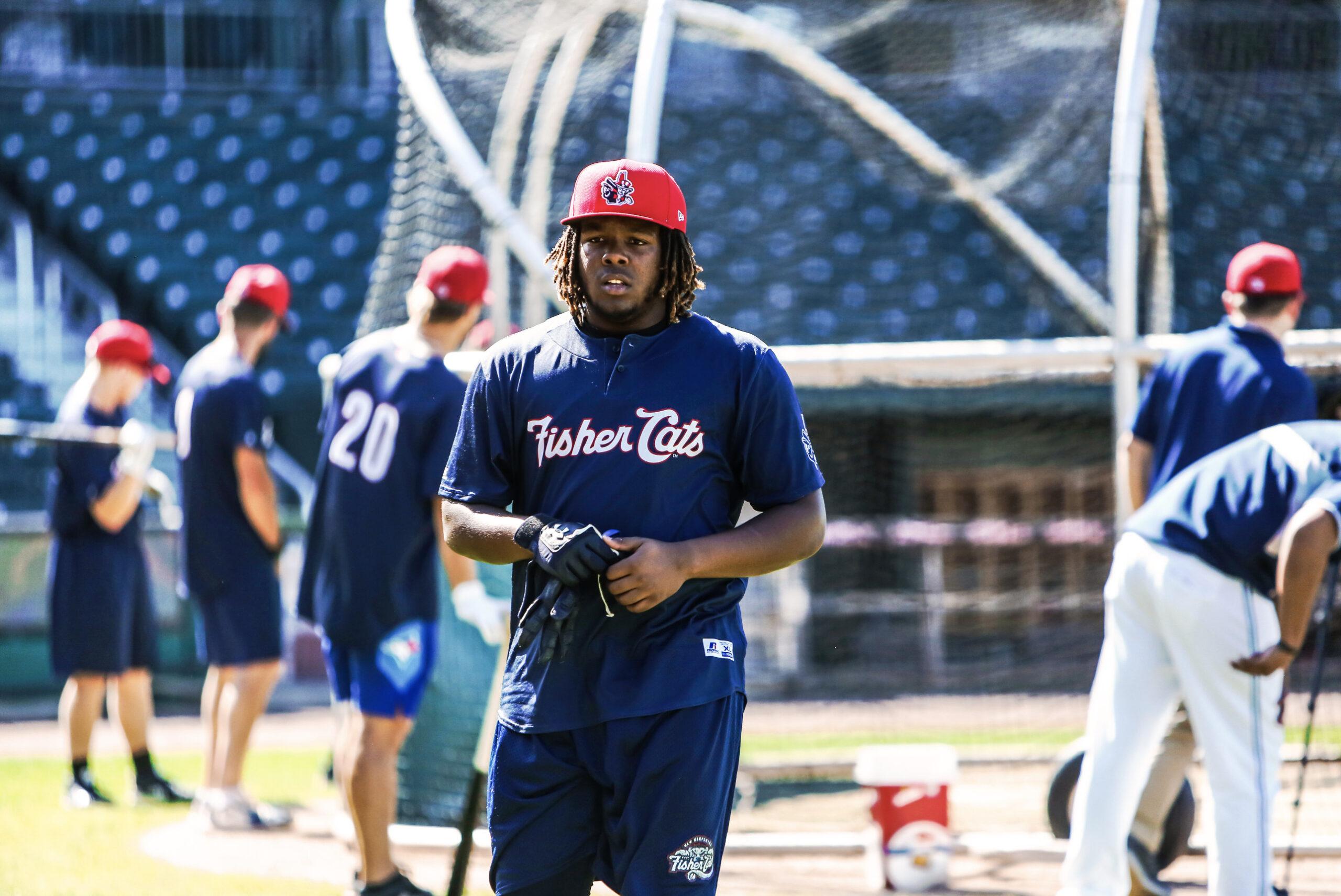
As usual, Vladimir Guerrero left his son some big ol’ mismatched shoes to fill in terms of making one’s presence felt in the big leagues early on. In his third game as an Expo, in 1996, Guerrero hit his first major league home run, and it was a doozy: top of the ninth, one out, down by two, Montreal in the playoff hunt, first pitch low and outside, utterly ill-advised swat—outta there, much to the comeuppance of snarky Atlanta Braves color commentator Don Sutton. It was the perfect introduction of Guerrero to the MLB, a concentrated dose of his unique talent. He would go on, over the course of his 16-season career, to attain a near-mythical status as, among other things, a man who could never lay off ’em, but also never really had to.
That’s not Vladito’s style, exactly, but he does share his father’s magnetic flair for the dramatic and his rare ability to turn any plate appearance into appointment viewing. Guerrero has put on a show so many times in his brief career that he sometimes gets asked a variation of this question: What moment stands out so far? What makes you most proud? If you want to hear him wax rhapsodic about that walk-off at Olympic Stadium, you might be disappointed; his typical answer is that the best is yet to come. “A future moment, maybe,” he says back in Manchester.
The timing of Guerrero’s call-up may have created irritating, nagging, unnecessary drama for more than a year now, but in the short term, at least, Guerrero’s call-up might provide some solace for his local fans. After the Toronto Maple Leafs lost in seven games to the Boston Bruins on Tuesday night, a reporter tweeted a quote from hockey coach Mike Babcock about not knowing where the Leafs would find offense. Many replied with the same clever suggestion: Vlad Jr. “My son!” Senior tweeted on Wednesday when Junior got the call, turning up the nostalgia to 11. “The country that saw you as a child will now see you turn into a big one.”
For years Vladito has been the Prince Who Was Promised: second of his name, the Dingerripper, unit of absolute, creator of content, bringer of joy. He has never not known the relentless burden of being his adored father’s cherished son, of being talked at by awestruck citizens who wish to relay their respects, eager to reminisce with him about memories that they’ll never forget but that he was too young to remember. “Hopefully, he becomes what everybody thinks he’s going to become,” Montoyo said on Wednesday. “That’s going to be good for all of us. The city of Toronto. The Blue Jays. The organization.’’
From his first plate appearance on Friday, Guerrero has the chance to write his own legacy, one informed by his roots but not forever tangled by them, as he transitions from teen sensation to big league rookie, faces talent that is befitting of his own, and plays baseball in a stadium whose size matches his ambitions. There’s a reason so many graduations are called commencements: They’re celebrations of new beginnings, of moving on out and moving on up.
Translations for Vladimir Guerrero Jr. and Kendrys Morales in this piece were provided by Paolo Uggetti.
